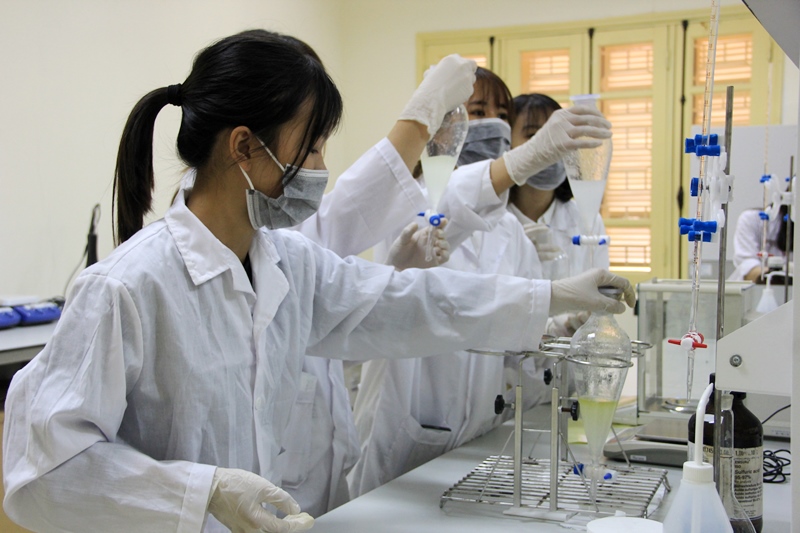Normally, everyone who works directly in the laboratory needs to wear protective equipment. So, why must you wear laboratory protective clothing? This article will help you get the answer. Let’s follow along now!
Why must we wear laboratory protective clothing?
Wearing protective clothing when working in the laboratory is extremely important and for many reasons, including:
- Protects the body from toxic substances: Laboratories often contain many chemicals, bacteria, and other dangerous materials. Protective clothing such as lab coats, hats, and gloves help protect workers’ bodies from direct contact with these substances, reducing the risk of injury or danger.
- Prevent the spread of hazardous substances: Wearing protective clothing helps prevent bacteria, viruses, or other harmful substances from spreading out of the laboratory. Keep your surroundings safe.
- Eye and skin protection: Goggles and lab coat help protect eyes from splashes and protect skin from direct contact with chemicals.
- Prevent contaminated clothing: Protective clothing helps prevent contaminants from personal clothing from entering the laboratory environment and vice versa. This ensures the purity of samples and experiments.
- Follow safety rules: Wearing protective clothing is an important part of laboratory safety rules. This helps ensure that workers comply with safety measures and reduce the risk of accidents.

What types of laboratory protective clothing are there?
There are many types of protective clothing used in the laboratory. Depends on the specific nature of the job. As well as the risk of exposure to dangerous substances. Here are some common types of laboratory protective clothing:
- Blouse: Blouse is one of the medical uniform models used in the laboratory. If the job does not require close contact with toxic chemicals. Wearing a white blouse may be enough.
- Lab coat: A type of long coat often worn in the laboratory. Can cover the entire body from shoulders to thighs. Lab coats help protect personal clothing and skin from chemicals, bacteria, and other exposure hazards.
- Helmet: Worn to protect the head from chemical splashes or dust. There are many types of protective helmets such as hoods or insulating helmets depending on the type of work.
- Protective gloves: Used to protect hands from direct contact with chemicals and other hazardous materials.
- Goggles: Worn to protect eyes from splashes or other hazardous materials.
- Special protective clothing: In some cases, special protective clothing may be required. Examples include fireproof vests, antistatic vests, or X-ray vests depending on the specific type of work.

How to choose laboratory protective clothing
Choosing protective laboratory clothing is an important process. Helps ensure safety and protect the health of workers. Here are some guidelines for choosing:
Choose the appropriate material:
- If there is a risk of exposure to chemicals. You should choose protective clothing that is waterproof and chemical resistant.
- As for the risk of infection. Choose clothing materials that are easy to clean and waterproof if necessary.
Check safety standards:
- Make sure your protective clothing meets safety standards and industry requirements.
- Check size to ensure fit and comfort.
Choose clothing with special safety features:
- If there is a risk of impact, choose clothing that is impact resistant or antistatic if necessary.
- For environments with X-rays, choose protective clothing that is resistant to X-rays.

The article answers the question: Why must we wear laboratory protective clothing? Please refer to it for more information.






 Tiếng Việt
Tiếng Việt

Sản phẩm
Red And Black Short-Sleeve Workwear Set
Red And Black Long-Sleeve Workwear Set
Blue And Grey Short-sleeve workwear set
BLUE+GREY LONG-SLEEVED WORKSUIT
CHARCOAL+GREY SHORT-SLEEVED WORKWEAR
CHARCOAL+GREY LONG-SLEEVED WORKWEAR
SHORT-SLEEVED REFLECTIVE GRAY WORKSUIT
LONG-SLEEVED REFLECTIVE GRAY WORKSUIT
GREY COORDINATE LONG-SLEEVED NAVY
NAVY POLO JERSEY
POLO BLUE+NAVY JERSEYS FOR MEN AND WOMEN
POLO JERSEY NAVY+WHITE MEN’S/WOMEN’S